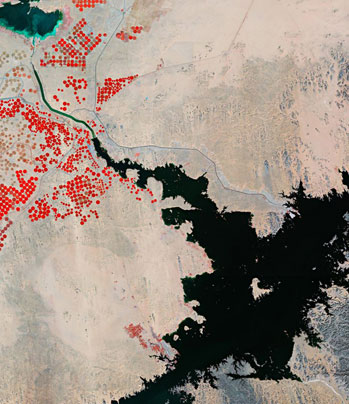Admire the image of the 5,250km2 wide artificial lake seen from space
On March 18, the European Space Agency released an image of Lake Nasser, one of the largest man-made lakes in the world, of the Copernicus Sentinel-2 satellite.
Lake Nasser, located in southern Egypt and northern Sudan, was formed by the construction of the Aswan Dam on the Nile River in the late 1960s. This ambitious project was designed to provide irrigation water for agriculture and attract people to the area. area. In the photo, this lake is in the lower right, in black.

Part of the artificial lake Nasser in this image of the Copernicus Sentinel-2 satellite.
The Aswan Dam is located about 200 km northeast of the area pictured. The dam stores floodwater from the Nile River and releases it when needed, helping to supply water to hundreds of thousands of hectares of land downstream as well as the surrounding area. The dam also improves traffic through Aswan and generates large amounts of hydroelectricity. The lake has a total surface area of 5,250 km2, with an average depth of 25 m.
The ancient Egyptian temple of Abu Simbel was once within the rising water of the Aswan Dam, so it needed to be relocated. In the 1960s, the historic site was partially disassembled and reassembled in a new location to prevent flooding. In the photo, the town of Abu Simbel and its airport are close to the bottom, near several plantations marked in red.
Part of Lake Toshka, a natural depression filled by overflow from Lake Nasser, appears in the upper left corner of the image. This lake was formed in the 1980s and 1990s by the diversion of water from Lake Nasser through the blue man-made channel in the image.
The water level of the lakes depends on the flow from the Nile. In 2012 - 2018, the lakes shrank significantly. However, summer rainfall in Sudan in 2019 and record flooding in 2020 caused the lake to rise rapidly. The lakes are relatively salty, signs of eutrophication and algae are also present in the image.
The image released by the European Space Agency (ESA) is a color-processed composite image created using the near-infrared channel of the Copernicus Sentinel-2 to highlight scarce vegetation in the region. region. This helps identify circular fields in the image, the largest of which is about 750m in diameter.
- Poopó Lake 1000km2 wide suddenly disappeared
- Mysterious about Lake Baikal - The largest lake in the world
- 10 lakes are beautiful but can kill people
- The poetic blue lake that attracts many photographers turned out to be a very dangerous place
- Discover places with fantasy beauty
- The largest artificial lake in the world
- Thousands of bird corpses cover a 200km2 wide lake
- The 200m-wide lake disappeared without a trace after a night
- Korea announced the image of Earth taken from space
- The largest tar lake in the world
- City of thousand years old at the bottom of the lake
- The lake of Iranian salt water turned red like blood
 Van Allen's belt and evidence that the Apollo 11 mission to the Moon was myth
Van Allen's belt and evidence that the Apollo 11 mission to the Moon was myth The levels of civilization in the universe (Kardashev scale)
The levels of civilization in the universe (Kardashev scale) Today Mars, the sun and the Earth are aligned
Today Mars, the sun and the Earth are aligned The Amazon owner announced a secret plan to build a space base for thousands of people
The Amazon owner announced a secret plan to build a space base for thousands of people